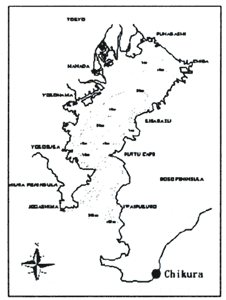|
EXPERIMENT IN REAL OCEAN
The object of experiment 2 was to check the effect on the growth of the seaweed
organism ( Undaria peterseniana), in the real ocean to use with or without iron fertilizer. Iron
fertilizer in this experiment included slag ( left side, Photo 2). The experimental
place is a section in the Chikura fishing port (Chiba, Japan), (Fig.3) and the date was from December
9, 2001 to February 16, 2002. The measurements had been carried out seven times on December 15, 27, January
11, 29, February 6, 11, and 16.
| (Enlarge: 25KB) |
 |
Figure 3 . Experimental place
As an arrangement of this experiment, a rope was set from one side to the other side on a raft, (Photo 11, Fig.4). Seaweeds were hung on the rope (Photo 12).
Photo 11. Raft used for experiment
Figure 4. Arrangement of this experiment
Photo 12. Position of seaweed hung by rope
The iron fertilizer was set at the same location and in an upper level with seaweed on only one side of the raft. This setting used three bags including iron fertilizer and each weight was 3 kg. At the other side of the raft, iron fertilizer was not set. We measured the wet weight after removing the seaweed from the rope, to check growth.
Photo 13. Position of iron fertilizer in upper level with seaweed
Results
Figure 5 shows the results in change of wet weight of the seaweed. After February 11, we can see obviously wet weight on the side used with iron fertilizer is much better than the other side. It supposedly had no effects on the results before February 11 but we decided to indicate wet weight between measured days (Fig.6). Now, we could see the wet weight between measured days using the iron fertilizer was almost increasing, compared with the other side.
We had re-set up this experiment on February 6, so we had two terms of this experiment in Figure 6. We got final results from Figure 6 that the growth rates using iron fertilizer were about 1.3 and 1.35 times compared with not using it.
Figure 5. Results of change of wet weight
Figure 6. Results of wet weight between measured days
Consideration
As a result from experiment 2, rate of increase on wet weight using iron fertilizer according to measured terms was good, compared with not using it. The wet weight between measured days using iron fertilizer was increasing. Therefore, we concluded that the iron fertilizer made the organism of seaweed have very good growth.
CONCLUSIONS AND REMARKS
Iron fertilizer including ferrous sulfate made the spore of seaweed have good germination. Existence and growth on spores of seaweed, by culture tank test, was noted in experiment 1. Iron fertilizer makes acceleration of growth on organism of seaweed in real ocean test as experiment 2. Therefore, it was shown that the iron fertilizer gave spore and organism of seaweed good growth effects. Basic results on algae enhancement technology were also obtained.
Here, we had considered the difference of number of germination of spore and organism of seaweed in case to use with iron fertilizer or without one in this research, but did not consider the comparison of the quantity of iron fertilizer. Our future work is to discuss about the quantity of the iron fertilizer by experiment, and to obtain quantitative results of iron fertilizer, so that we can apply this technology to create or improve seaweed communities.
ACKNOWLEDGEMENT
We would like to thank to Mr. Y. Izawa who had helped with these experiments.
REFERENCES
Hotta, K., T. Suzuki, N.T. An, B.H. Long, N.H. Dai and P.H. Tri. 2000. An Experimental Study on Artificial Reef for Algae Enhancement Technology: Effects of Iron Ion, Abstract of the Ninth Pacific Congress on Marine Science and Technology, pp.112.
Hotta, K. and T. Suzuki. 2000. A Study on Practical Experiment of Ocean Fertilizing Technology Using Nutrient Salts for Restoration of Marine Resource Production, Abstract of the Ninth Pacific Congress on Marine Science and Technology, pp.110.
Izawa, Y. 2002. An Experimental Study of Algae Enhancement Technology by Use of Iron Fertilizing, Master's Thesis, Nihon University.
Sudo, S. 1948. Shedding, Swimming and Fixing of the Zoospores in Some Species of Laminariaceae, Proceedings of Japan Society of Fishery Science, Vol.13(4):123-128.
Takeda, S. 1996. Micronutrient and Plant Plankton, KAIYO MONTHLY, Ex.Vol.10:69-77
|